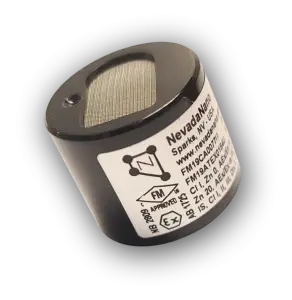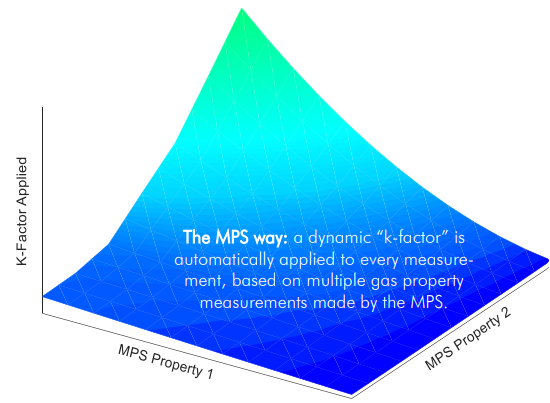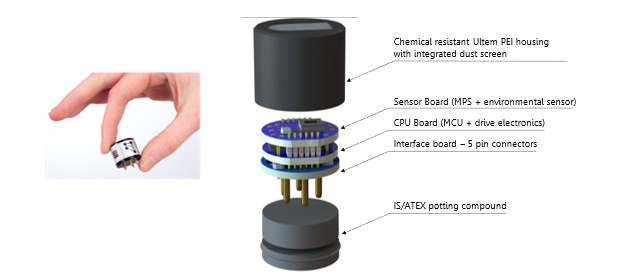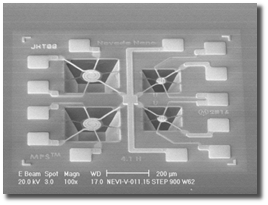Molecular Property Spectrometer™ (MPS™) Gas Sensors
The smart gas sensor that eliminates the need for field calibration.
The bedrock of our technology is NevadaNano’s proprietary Molecular Property Spectrometer™ (MPS™) sensor. Originally developed for the Defense Advanced Research Projects Agency (DARPA), the Department of Homeland Security (DHS) and the Department of Defense (DOD) for demanding military and anti-terrorism applications, it has now been adapted for commercial applications. In a testament to the breakthrough technology incorporated in the sensor, thirty patented inventions and over one hundred trade secrets power the technology.

The MPS™ is a new type of sensor that fuses a broad range of innovations from four key disciplines:
- Exceptionally reliable silicon Micro-Electro-Mechanical System (MEMS) forming the transducer that translates chemical information into electrical signals.
- Precision electronics with powerful computational capability for analyzing the gas at the point of detection.
- Two levels of patented chemical analysis protocols — one for analyzing the chemical and one for analyzing the data, temperature, pressure, and humidity measurements to enable environmental compensation for accurate readings in all environments and
- State-of-the-art control technologies such as Built-In Self-Test (BIST) and system supervision (watchdog monitoring) to enable certification to the highest safety standards.
These technologies give MPS™ sensors best-in-class performance as the industry’s first sensor not requiring field calibration. This allows the sensors to be used in the many applications where quarterly calibration is too expensive, applications like consumer and commercial monitoring, where routine service calls would be unacceptably expensive, or remote industrial sites where travel time imposes a cost penalty and sites that require a high number of monitoring points, such as refineries, where calibration would become overwhelming. With a 15+ year life and no service requirements, the MPS™ technology enables all these applications.
Features & Benefits
- No requirements for periodic field calibration.
- 15+ years of sensor life.
- Sensor immunity from poisoning.
- Wide environmental working range (-40 to 75 deg C and up to 100% humidity).
- Accurate readings regardless of the environmental conditions.
- Ability to detect Hydrogen and Methane.
- Unique ability to automatically classify the type of gas in the environment.
- Global approvals of device safety and manufacturing quality (ATEX, UL, IECEx)
- Two form factors, an industry standard 4 Series and a low profile “Mini” package facilitate integration into your product.
MPS™ sensors provide worker safety and gas leak detection in a wide range of industries including oil & gas, chemical production, power generation, wastewater treatment, landfill monitoring, confined space entry, heating, and transportation industries. The sensors are available in digital or analog configurations for ease of use and certified for all flammable gas environments with ATEX, UL and IECEx certifications.
How it Works
The Molecular Property Spectrometer™ (MPS™) is a high precision Micro Electro-Mechanical System (MEMS) that measures the molecular properties of chemicals in the air to determine the type of chemical present and the concentration of that chemical. The term “molecular property” refers to any measurable or descriptive characteristic or feature of a molecule. Examples of these properties include physical characteristics such as size, shape, mass, density, and melting or boiling point, or chemical characteristics such as polarity, reactivity, acidity/basicity, and solubility or thermodynamic characteristics such as thermal conductivity, specific heat, phase transitions and exothermic and endothermic reactions. The MPS measures different properties depending on the application, however thermodynamic properties often provide a rich source of information about the molecule. These properties are the focus of the MPS sensors on the market today.
While many people associate the word “spectrometer” with light-based analysis systems, it more accurately refers to any device that measures a spectrum of properties, which in the case of the MPS, means a spectrum of molecular properties. Spectrometers are widely used in various fields including physics, chemistry, astronomy, environmental science, and biology due to their ability to provide comprehensive information to the user.
The Technology
A micromachined silicon transducer that enables high precision measurements of the molecular properties of the gas. A specialized silicon foundry fabricates these devices with excellent dimensional precision, resulting in extraordinary sensitivity and accuracy. In addition, the microscopic size of the sensing element, similar in size to a human hair, enables the sensor to measure gas concentrations in milliseconds, minimizing power consumption. The combination of small size and fast operation enables long life with battery powered operation. Additionally, the high temperature materials used in the sensor provide exceptional stability and immunity to poisoning, enabling the MPS sensor to operate for 15+ years without needing calibration.
Precision electronics provide electrical signals to the transducer and measure the output of the transducer under the influence of the gases in the air. These electronics enable the sensor to accurately measure concentrations at the part-per-million (ppm) level.
A powerful microprocessor in the MPS provides edge computing for six major functions in the MPS, enabling a smart sensor that can measure a wide variety of gases or customized for optimum performance in diverse applications:
- Precise control of the sensor initialization protocol on startup to ensure accurate readings.
- Control of the chemical analysis protocols such as the timing, temperatures, power, measurement frequency, and duty cycle used to analyze the chemicals.
- Environmental compensation: Adjustment of the data for the current temperature, pressure, and humidity using custom compensation algorithms to allow the sensor to report accurate readings during use in extreme environments.
- Analysis of the data using proprietary chemometric algorithms to determine the gas type and the concentration of gas detected.
- Formatting and providing the data output in the user desired format: for example, analog or digital to facilitate integration into your products.
- Supervisory control of the entire sensor including Power-On-Self-Test (POST) and Built-In Self-Test (BIST) ensures that all sensor systems are performing to specification. POST and BIST perform comprehensive system checks to ensure that the sensor is operating in spec.
- Execution of different versions of firmware for various products, enabling the sensor to serve the Flammable Gas safety market with LEL (Lower Explosive Limit) sensing, the HVAC-R market with a wide variety of refrigerants, and the leak detection markets with high sensitivity, extended range (XR) sensing.
Sensor Firmware customized for various gases and applications enables well proven sensing technology to serve a wide variety of products and applications. The same hardware, from transducer to housing, serves all our sensor products, providing you with highly reliable sensing from a stable, trusted platform.
Environmental Compensation is the process of measuring the instantaneous temperature, pressure and humidity and using proprietary algorithms to compensate for extremely high and low temperatures, pressures and humidities. This technology ensures accurate readings from -40C to +75C, 80 – 120 kPa pressure and 0 – 100% humidity.
Intrinsically Safe Design with ATEX Zone 0, IECEx Class 1 Div 1, Underwriters Lab (UL) and Factory Mutual (FM) certifications enables users to utilize our sensors in potentially flammable environments with confidence. For more information on our certifications, click here
TrueLEL™ Technology
Our TrueLEL™ technology uses proprietary measurement and data processing techniques to classify the gas type and automatically apply the correct sensitivity factor in the MPS flammable gas sensors. This sensitivity factor, often called a “k factor,” ensures accurate readings for a wide range of gas types without advance knowledge of the exact mix of the gases in the environment and without manually inserting a k factor into the detector. This technology, available only from NevadaNano, provides workers with accurate gas readings even if the gas type changes or there is a mixture of gases in the vicinity.
Gas Classification
The old way: Conventional sensing technologies (e.g. catalytic bead, NDIR) use a “k-factor” multiplier to convert raw sensor signals to gas concentrations in % LEL. These “k-factors” are based on known relative sensitivities of these sensors to different gases. A single “k-factor”, corresponding to a particular gas, must be selected manually during system setup; if the sensor is then exposed to a gas other than the one selected, significant errors in reported concentration can occur.
The MPS™ way: The MPS™ Flammable Gas Sensor applies a real-time conversion factor automatically, using the latest measured thermal properties of the ambient air/gas and the environmental conditions. The %LEL values reported for the bulk, which may contain a mixture of gases, achieves the same high levels of accuracy achieved with single gases.



